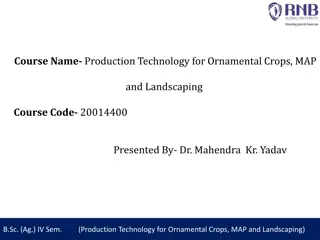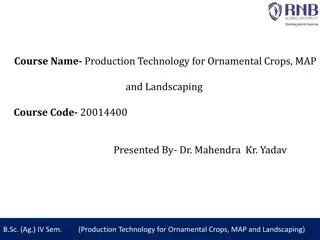Comparative Analysis of Organic and Conventional Cultivation of Medicinal and Aromatic Plants in Albania
This report delves into the challenges and advantages of organic and conventional cultivation of Medicinal and Aromatic Plants (MAPs) in Albania. Issues such as price fluctuations, market trends, and quality considerations are explored. Organic markets offer benefits in quality and client satisfaction despite initial costs, while conventional markets struggle with fluctuating prices and selling difficulties. Understanding the differences between the two approaches is crucial for farmers and businesses in the MAP industry in Albania.
Download Presentation

Please find below an Image/Link to download the presentation.
The content on the website is provided AS IS for your information and personal use only. It may not be sold, licensed, or shared on other websites without obtaining consent from the author.If you encounter any issues during the download, it is possible that the publisher has removed the file from their server.
You are allowed to download the files provided on this website for personal or commercial use, subject to the condition that they are used lawfully. All files are the property of their respective owners.
The content on the website is provided AS IS for your information and personal use only. It may not be sold, licensed, or shared on other websites without obtaining consent from the author.
E N D
Presentation Transcript
Local economic development project Organic cultivation versus Conventional production of Organic cultivation versus Conventional production of Medicinal and Aromatic Medicinal and Aromatic Plants in Albania Plants in Albania November, 2019 November, 2019
Main issues encountered in conventional production Fluctuations in the price for some MAPs: Sage from about 200 to 100 ALL/kg Lavender from about 350 to less than 200 ALL/kg Thymus increased up to 300 ALL/kg Difficulty in selling big amounts of products. Lack of clarity related to market trends/demands. Lack of Contracts.
Comparative Analyses of organic and conventional Markets Conventional Market Considerable amounts of a wide variety of MAPs (sage, lavender and 203 other MAPs) Organic Market Relatively small amounts of varieties based on their usage (teas , essential oils) Needs It changes based on several marker factors; However it remains restricted in a relatively cheap price; The clients ask for well negotiated quantities and prices. It is more guaranteed for both parties; It has initial organiation and coordination costs; High trasnfering prices compared to the convential market; Benefits Big quantities of good quality. The quality of the product., the soil where it is cultivated, the way it is treated before and after harvesting, certification etc. What they pay for
Comparative analyses of organic and conventional products. Conventional Market Potential for securing the required quantity from the buyers only for the sage; The rest is spontaneous selling. Organic Market Potential for a considerable number of products with average quality. Types of products Often not considered in the relationship between the byers and the sellers. Highly important for the organic certification. Quite often it requires lands not planted for the last three years. Importance of the lands where it is cultivated Pre and post harvest care Some exporters might ask for it, although not much attention is paid. ( attentions especialy realted to drying) It has an important focus on the procedures followed for plant nutrition and it treatment after. Sharvesting schedule It is not very important for the buyers. Highly important especially in essential oil production. Frequent monitoring before harvesting the plants. Big volumes of the products are required by most exporters. Average to big volumes for some products especially for those with high market demands (especially in the organic market). Taking into account the costs for coordination , harvesting and post harvest care, packaging and traceability , the transfer costs vary from 25-30 ALL /kg for some plants and even higher for the others. The main risks are not related to the market or the behaviour of the buyers but to the performance of the farmers securing the quality. Quantity of the product The production costs are from 10-15 ALL /kg lower than the selling costs for the farmers/ cooperatives. These include the transferring costs from the farmers to the traders. There is high market uncertainty for some products such as sage.. There is also uncertainty in the behaviour of buyers. Cost of the product Risks related to the products
Comparative analyses of selling channels and relations with buyers. Conventional Channels It requires minor attempts. The number of big exporters is high who are always seeking favourable "bargains . Organic clients It requires considerable attempts. Quite often the exporters of the organic products require better quality not quantity. Their numbers are small but it is more difficult to convince them. Awareness related to the products Assessing the product. The value of the product is based on its appearance (the way it looks, other unwanted objects/materials , level of cleaning etc.) The value of the product and selling it depends on soil properties, level of chemicals and many other elements. The assessment is a continuous process. Buying the products Buying and selling is spontaneous and sometimes is based on verbal agreements. Buying and selling is organised based on the contracts and agreements which define the required quantities and quality. Adjustments are done depending on the results and quality assessed by the buyers. Continuous coordination related to the quantity, quality monitoring and certification. Support after buying There is no support provided . Relations between producers and buyers. Sporadic coordination, transactions based mainly on the price.
Incomes and benefits (organic versus conventional) It is easier to increase incomes for the conventional plants(the benefits margins are higher for the cooperatives rather than collectors) The organic presents challenges in the cases where the lands require treatments with fertilizers ( half of the production can be obtained despite the higher prices) It enables the negotioation opportunities in the transection and eventually in selling. It requires fixed investments in certification. It requires better coordination for the cultivation.
Other trends in the sector Increase in vertical growth (companies such as Relikaj, Keka, etc) have invested in cultivation. The same actors are dealing with the organic too. Some countries in the Balkan region are competing with Albania(Bosnia, Montenegro and Serbia for some plants). High competition among exporters and total lack of contracting.
Activities What should be done ? Aktivitet cilat jane detyrat? Weak post harvest care Lack of traceability Improper processing process. Considerable changes in quality. Unstable relations with some buyers. Improper cultivation techniques Situation and challenges Production Certification standards (Who can secure continuous information of the farmers? Monitoring? ) Cooperation with buyers , which are the challenges in this direction?) Logistics , harvesting , drying Organization of a drying process involving farmers?! Coordination of harvesting and drying with the farmers . Selling to foreing clients Preparation of contracts as a solution to uncertainties. (How to forecast the production which can be contracted? What are the main issues ? What prices ?) Solutions and tasks Other steps Information gathering . Coordination with buyers and farmers. Establishing a system of production. Keeping costs under control .























